Bulletin – September 2013 Australian Economy Indicators of Labour Demand
- Download the article 599KB
Abstract
There are several indicators of labour demand that can be used to assess labour market conditions and as inputs into forecasts of employment growth. These include measures of job vacancies, job advertisements and business surveys of employment intentions. Over the past year, there have been pronounced declines in a number of these indicators and employment growth has been somewhat subdued. This article suggests that as well as being a source of information on current labour market conditions, these indicators provide some leading information on employment growth, although the forecasting performance of models including these indicators is only slightly better than that of a simple benchmark model.
Introduction
Employers looking to hire new staff generally engage in various activities to find suitable employees. Jobs vary according to the skills employers require and the location of the business, while prospective employees vary in their qualifications, experience and ability, which may be hard for employers to assess. Moreover, hiring a new employee entails costs such as training (or, if the wrong choice is made, the costs associated with termination). To find a suitable candidate for a job, employers conduct recruitment activities to attract and screen potential candidates.
Indicators of firms' demand for new employees provide a valuable gauge of the state of the labour market. There are several such indicators, including:
- the Australian Bureau of Statistics (ABS) survey of job vacancies
- job advertisements in print media and on the internet
- business surveys of employment intentions of firms.
One advantage of such indicators is that they may point to a change in conditions before it becomes apparent in the employment data. For example, when a firm's demand for labour increases, it may engage in recruitment activities (e.g. by advertising new vacancies) for several months or more before the vacant positions are filled. Similarly, a fall in the demand for labour may be observed in a slowing in search activity before the effect on employment growth becomes apparent. For this reason, these measures are often called ‘leading’ indicators of employment.
This article explores the relationship between these indicators and employment growth. First, the theoretical role of job vacancies as an indicator of labour demand is reviewed. A range of other indicators is also assessed, noting the strengths and limitations of each. A number of empirical techniques are used to evaluate the strength of the relationship between employment growth and these indicators, as well as the extent to which they might be useful in forecasting future employment outcomes.
Job Vacancies, Employment and the Beveridge Curve
The ABS defines a job vacancy as a position that is available to be filled immediately, is open to external applicants and for which recruitment action has been undertaken.[1] The number of job vacancies is a key indicator of unmet demand for labour in the economy. Under some simplifying assumptions, the increase in employment in a given period will equal the number of job vacancies that are filled in the period (‘matches’) less the number of people that leave a job for any reason (‘separations’).[2] When demand for labour is strong, the level of vacancies will generally rise, which in turn tends to lead to higher employment growth as these vacancies are filled. Not surprisingly, employment growth has been positively related to the vacancy rate (i.e. the number of vacancies scaled by the labour force) over time, although this relationship is not especially close as employment growth has also been influenced by a range of other factors (Graph 1). In particular, in any given period employment growth will also be affected by:
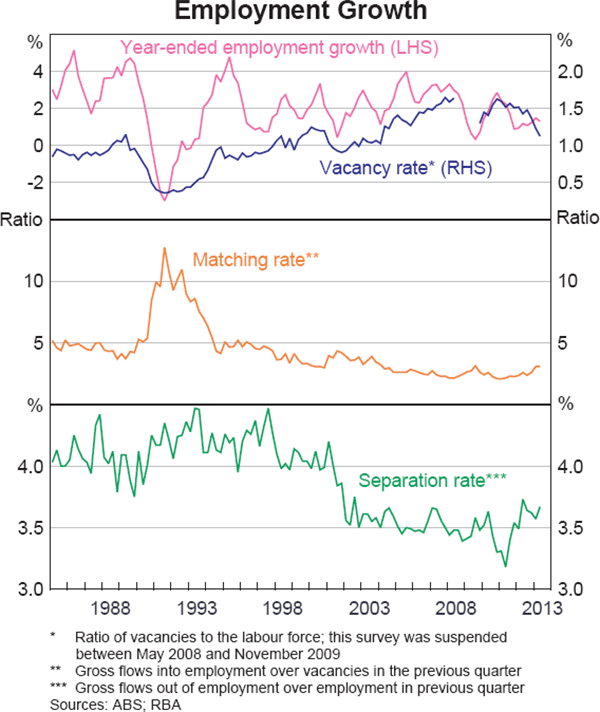
- the likelihood that a vacancy is filled, which is also known as the matching rate
- the likelihood that an employed person leaves his or her job, either due to retirement, resignation or retrenchment, which is also known as the separation rate.
The matching rate is the rate at which vacancies, which reflect unmet labour demand, are matched to the stock of available workers, which will be influenced by determinants of labour supply such as the labour force participation rate and/or population growth.[3] The negative relationship between the number of vacancies and the number of unemployed persons (both as a proportion of the labour force) is illustrated by the Beveridge curve (Graph 2). As well as providing information on factors affecting the matching rate, the economy's position on and movements along the Beveridge curve can also provide an indication of broader labour market conditions. For example, when labour market conditions tighten, the unemployment rate will fall while the number of vacancies will rise as firms search for more labour. This will result in a movement up and to the left on the Beveridge curve. In these circumstances, it will be harder for employers to find suitable labour and hence the matching rate may fall.[4] The reduction in the unemployment rate and increase in the vacancy rate over the past two decades is consistent with the matching rate having declined over the same period (the available data provide an imperfect proxy for the matching rate, for reasons discussed below). Shorter-term movements along the Beveridge curve have also been observed during this time, in line with cyclical changes in labour market conditions.
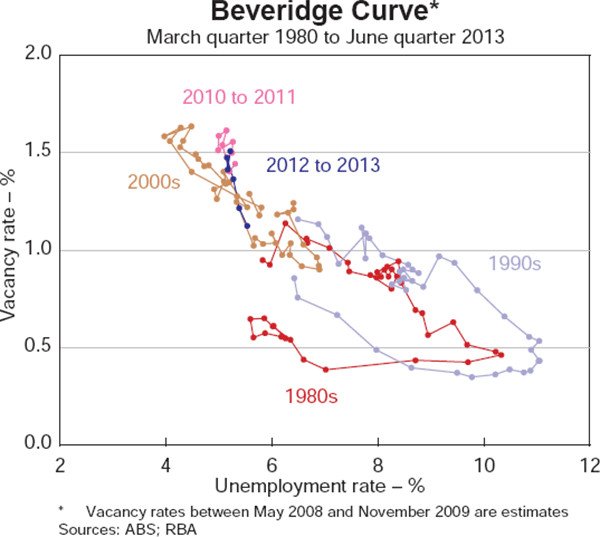
The matching rate will also be affected by structural developments in the matching efficiency of the labour market; that is, the rate at which vacancies are filled for a given number of unemployed. Matching efficiency is reflected in the position of the Beveridge curve relative to the origin. Changes in labour force mobility are an important influence on matching efficiency: if the labour force is more mobile, with workers better able and more willing to move across different occupations, industries or geographical locations, then (for a given level of unemployment) vacancies should be easier to fill. Matching efficiency may also be affected by developments in recruitment technology. For instance, the increased use of online job advertisements may have made it easier for firms to find and screen potential candidates and made it easier for jobseekers to find opportunities of interest.
Changes in the separation rate may also affect the relationship between job vacancies and employment growth. Job separations fall into two broad categories, depending on whether it is the firm's or the employee's decision to separate. Involuntary separations, which are initiated by firms and account for about one-third of all separations, tend be countercyclical – rising during economic downturns as firms downsize their workforce or even close entirely. On the other hand, voluntary separations, which are initiated by employees, tend to be procyclical. Employees will tend to be more willing to bear the costs and risks of changing jobs when economic conditions are strong, and the gains from leaving a job will generally be higher in a tighter labour market in which firms are competing more intensely for labour.[5]
The resources boom in Australia over the past decade is likely to have affected rates of both matching and separation. In particular, the shift in activity toward mining and mining-related industries and geographical regions may have led to a mismatch between vacant positions and the supply of labour, thereby reducing the matching rate. Graph 2 suggests that the level of vacancies in 2010 and 2011 was slightly higher than that implied by the historical relationship between vacancies and unemployment, indicating that the matching efficiency of the labour market may have declined somewhat during this period.[6] At the same time, structural change in the economy may result in a higher separation rate, as firms in some industries reduce their number of employees and as labour moves towards industries and regions where demand is higher. Together, these factors suggest that a given rate of employment growth will tend to be associated with a higher vacancy rate in periods of structural change.
The Job Vacancies Survey
Each quarter, the ABS publishes a measure of job vacancies estimated from a survey of approximately 4,800 employers.[7] Importantly, the ABS measure of vacancies records the stock of vacancies on a particular day in the quarter (the survey date), which is smaller than the total number of vacancies available to be filled during the quarter. This is one reason why deriving a reliable estimate of the matching rate from the data is difficult: the number of people becoming employed in any given quarter (derived from the ABS data on gross labour flows) is typically much greater than the recorded stock of vacancies on a particular day within that quarter.[8]
There are a number of other measurement issues associated with the vacancies data. In particular, the costs associated with recruitment action may mean that some firms have vacant positions that do not meet the ABS criteria and hence are not recorded as vacancies. To the extent that these costs have fallen over time (e.g. owing to the developments in recruitment technology outlined below), this will tend to complicate any comparison of the level of vacancies in the recent period with the level of vacancies in previous years. Relatedly, a hire may result from a candidate approaching a firm that at the time had no vacant positions, in which case the number of recorded vacancies would again tend to understate the number of positions available to be filled. Although it is difficult to estimate how common this is, the 2012 ABS survey of job search experiences suggests that a significant share of new employees look for work by contacting friends or directly contacting an employer. Finally, increases in the number of employers and people who work on their own account will generally not be associated with the filling of vacant positions.
Job Advertisements
Job advertisements are an alternative measure of the level of recruitment activity. Data on job advertisements are published by three main sources: ANZ, SEEK and the Department of Education, Employment and Workplace Relations (DEEWR). Of these, the ANZ series are the longest running, with the newspaper component extending back to 1975 and the internet component to 1999. These series measure the stock of job advertisements on a specific weekday in each of the weeks of the month (and then take an average). On the other hand, DEEWR and SEEK provide measures of flows – that is, the number of new job advertisements posted in the month.[9]
These series are published every month and are timelier than the quarterly vacancies data. Unlike the vacancies data, which are collected from a representative survey of firms, measures of job advertisements attempt to capture the ‘population’ of advertisements, and so are not subject to sample noise. On the other hand, job advertisements have several drawbacks, in particular they:
- are affected by changes in recruitment methods and costs due to new technologies
- may not be representative of labour demand in the aggregate labour market
- can be affected by double counting.
Advertising technology
In the 1980s and 1990s, the number of job advertisements – at the time predominantly in newspapers – was significantly lower than the number of vacancies recorded by the ABS (Graph 3). With the growth of internet advertising from the late 1990s, the total number of advertisements increased substantially relative to vacancies, while the number of newspaper advertisements declined. In 2008, the stock of internet advertisements (as measured by ANZ) was around 30 per cent above the number of recorded vacancies. The slowdown in economic activity during the financial crisis was associated with a sharp fall in job advertisements, and since then the levels of vacancies and job advertisements have been broadly similar.
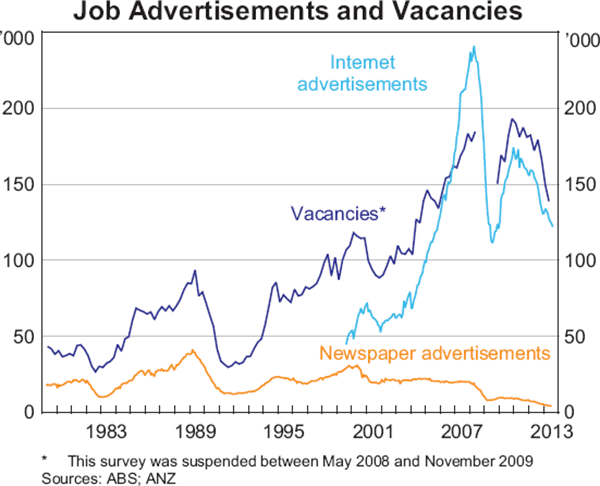
Some of the growth in online job advertisements may be attributable to the relative costs of the various recruitment methods. Online advertising has generally been a more affordable option for employers than advertising in newspapers. Online advertisements might have also replaced, or been used as a complement to, other recruitment channels such as job noticeboards. While online job advertisements now dominate the newspaper market in terms of volumes, in the 2012 ABS survey of job search experiences close to 20 per cent of recent employees stated that they had answered a print advertisement, indicating that the print market remains an important part of the recruitment process (Graph 4). Moreover, a substantial proportion of recent employees did not indicate that they had answered a job advertisement, suggesting that other means of searching, including directly contacting potential employers or talking to friends and relatives, also play an important role.
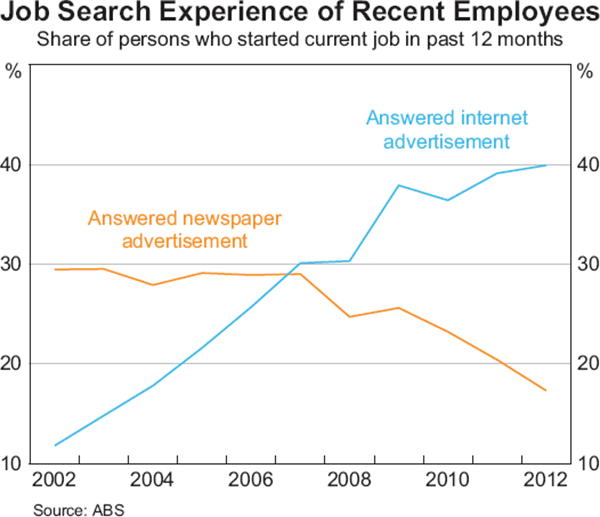
A more recent development has been recruitment through social media sites, such as LinkedIn, which reportedly had around four million registered users in Australia in early 2013 (Fitzsimmons 2013). While the number of job advertisements posted on the site is relatively low, LinkedIn allows recruiters to directly approach potential candidates with specific characteristics, including those not actively searching for new employment opportunities, without the need to advertise a position. In this way, the increased use of alternative recruitment channels such as LinkedIn may account for some of the recent decline in measures of job advertisements. It may also have had an effect on the broader relationship between job advertisements and job vacancies, to the extent that some vacancies are now being filled via such channels without being advertised first.
Industry and job composition
While the job vacancies data are constructed to be representative of the broader labour market in terms of states, industries and firm size, there is no assurance that job advertisements measures will be similarly representative, as some types of vacancies may be more likely to be advertised than others. Over time, there appear to have been some differences between the distribution of vacancies and advertisements across the states, which may in turn reflect differences in industry and/or occupational composition. For instance, the share of job advertisements in Western Australia has been substantially smaller than the share of vacancies in recent years, while the opposite is true for New South Wales (Graph 5).
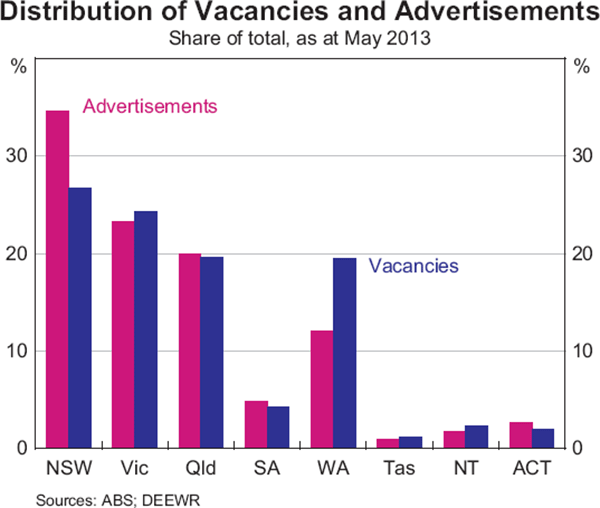
Double counting
Apart from SEEK, the available job advertisements series cover more than one source website and/or newspaper (Table 1). Accordingly, there is the potential for the same advertisement to be counted multiple times if it is posted across multiple sources, either in print or online media. There is also the possibility that an advertisement for the same vacancy will be posted multiple times on the same source. While some of the published series attempt to control for ‘double counting’, in practice it may be difficult to do this with precision.
| Advertisement series | |||
|---|---|---|---|
| ANZ | SEEK | DEEWR | |
| Source websites | |||
| SEEK | ✓ | ✓ | ✓ |
| CareerOne | ╳ | ╳ | ✓ |
| MyCareer | ╳ | ╳ | ✓ |
| JobNet | ╳ | ╳ | ✓ |
| JobSearch | ✓ | ╳ | ✓ |
| Print ads | ✓ | ╳ | ╳ |
|
Sources: ANZ; DEEWR; SEEK |
|||
If adjustments are not made for double counting (or if the adjustments do not account for double counting in full), a change in the number of advertisements may not be the result of a change in the number of vacancies, but instead reflect a change in the efforts of firms to identify and recruit applicants or a change in the cost of advertising. For instance, tighter labour market conditions may cause employers to increase their search activity by advertising their positions with more than one source, or by posting their advertisements multiple times within a month. This may help to explain why the cycles in the job advertisements measures tend to be more exaggerated than the corresponding cycles in the number of job vacancies (Graph 6).
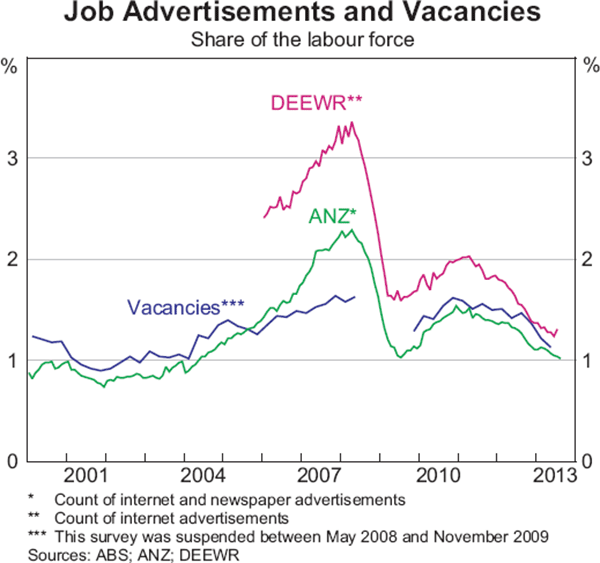
Business Survey Measures
Business surveys of employment intentions report the net balance of firms expecting to increase employment in the coming quarter (Graph 7). Two frequently cited surveys are the quarterly National Australia Bank (NAB) and ACCI-Westpac measures of employment intentions. The NAB survey includes responses from around 900 firms in the non-farm business sector each quarter, while ACCI-Westpac surveys around 300 firms in the manufacturing industry. The NAB survey sample is designed to be broadly representative of the aggregate economy in terms of state, industry and firm sizes, although firms with less than 35 employees are excluded. The Reserve Bank also discusses hiring intentions with businesses that participate in the Bank's liaison program.
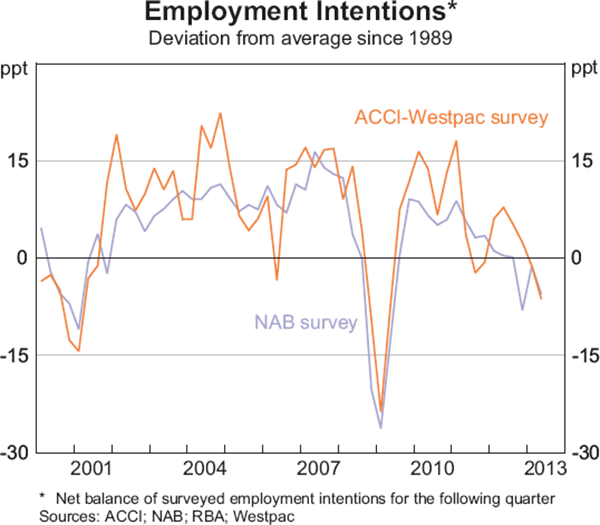
In theory, these measures may be more closely related to employment growth than job vacancies and advertisements inasmuch as they also take account of firms expecting to reduce headcount. However, there are a range of issues associated with the interpretation of business survey measures, including: they are subject to sampling error and other potential biases associated with survey design; they provide limited quantitative information as they often only ask firms if employment is expected to be higher or lower in the next quarter; and there may be variation in the way that firms report their individual experiences.[10]
The Relationship with Employment Growth
Changes in labour demand, as measured by these indicators, can flow through to employment growth in a number of ways. For example, an improvement in business confidence may initially translate into a re-evaluation of employment intentions, and then an increase in the number of job vacancies and advertisements. It may also prompt an increase in search intensity in those firms where vacancies already exist. Increases in employment, on the other hand, will be recorded at the point at which the associated recruitment processes result in new hires, which may be a number of months ahead. Consistent with this, quarterly changes in job vacancies and advertisements are positively correlated with employment growth one and two quarters ahead, as well as contemporaneously, as is the net balance of employment intentions from business surveys (Table 2). Over the past decade or so, the correlations with employment growth one and two quarters ahead have been higher than the correlations with employment growth one quarter earlier, suggesting that these indicators have tended to lead changes in employment.
| Lead | ABS Job Vacancies | NAB survey | ACCI-Westpac survey | ANZ Print | ANZ Internet | SEEK | DEEWR |
|---|---|---|---|---|---|---|---|
| 2000:Q1–2013:Q2 | |||||||
| −1 | 0.17 | 0.35 | 0.30 | 0.08 | 0.30 | ||
| 0 | 0.46 | 0.50 | 0.48 | 0.32 | 0.57 | ||
| 1 | 0.24 | 0.49 | 0.40 | 0.55 | 0.47 | ||
| 2 | 0.48 | 0.49 | 0.42 | 0.40 | 0.31 | ||
| 2000:Q1–2008:Q2 | |||||||
| −1 | 0.11 | 0.23 | 0.15 | −0.13 | 0.04 | ||
| 0 | 0.35 | 0.34 | 0.36 | 0.07 | 0.38 | ||
| 1 | 0.09 | 0.39 | 0.31 | 0.49 | 0.27 | ||
| 2 | 0.53 | 0.55 | 0.44 | 0.27 | 0.11 | ||
| 2008:Q3–2010:Q2(b) | |||||||
| −1 | 0.14 | 0.29 | 0.39 | −0.03 | 0.56 | 0.29 | 0.28 |
| 0 | 0.81 | 0.84 | 0.84 | 0.62 | 0.87 | 0.78 | 0.79 |
| 1 | 0.74 | 0.83 | 0.76 | 0.94 | 0.72 | 0.88 | 0.83 |
| 2 | 0.30 | 0.30 | 0.29 | 0.66 | 0.18 | 0.45 | 0.51 |
| 2010:Q3–2013:Q2 | |||||||
| −1 | 0.26 | 0.42 | 0.59 | 0.49 | 0.51 | 0.47 | 0.63 |
| 0 | 0.47 | 0.26 | 0.36 | 0.34 | 0.81 | 0.61 | 0.70 |
| 1 | 0.33 | −0.20 | −0.02 | 0.21 | 0.19 | 0.31 | 0.31 |
| 2 | 0.27 | −0.14 | −0.24 | −0.25 | −0.34 | −0.31 | −0.40 |
|
(a) A correlation at lead x refers to the correlation between the quarterly change
in the indicator (except for the NAB and ACCI-Westpac surveys for which
the level is used) and employment growth x quarters ahead; for each
indicator, the highest correlations among leads −1 to 2 are shown
in bold Sources: ABS; ACCI; ANZ; DEEWR; NAB; RBA; SEEK; Westpac |
|||||||
Although employment growth in any period will be a function of the number of vacancies at the start of the period (and the rate at which they are matched to jobseekers), employment growth was found to be more highly correlated with the change in vacancies than the level of the vacancy rate. The change in vacancies is also found to be more useful than the vacancy rate in the simple modelling exercises discussed below. There are a number of possible reasons for this: as discussed earlier, instability in the matching and separation rates over time, due for example to structural changes in the economy and/or developments in recruitment technology, can act to complicate the relationship between employment growth and the level of job vacancies. Various measurement issues associated with the vacancies data may also make it more difficult to interpret the recorded level of vacancies in any given quarter. On the other hand, changes in the number of vacancies from quarter to quarter can provide an initial signal of changes in labour demand, while potentially being less affected by structural changes.
The correlations for different sample periods suggest that the strength of the relationship between these indicators and employment growth has varied over time, although there are relatively few observations in the more recent periods. At certain times, for instance during the global financial crisis, changes in employment growth may be primarily attributable to shifts in labour demand, which would act to increase the correlations relative to other periods in which developments in labour demand and labour supply (such as changes in the participation rate) both play a role. Changes in the job advertisements market may have also affected some of these correlations over time. The leading relationship appears to have weakened across most of the indicators in the past few years, although the contemporaneous relationship between the internet job advertisements measures and employment growth has been relatively strong.
Forecasting performance
Indicators of labour demand are commonly used as an input into near-term forecasts of employment growth. Econometric estimates suggest that the addition of lagged values of these indicators to simple autoregressive models of employment growth improves their explanatory power. For instance, a model which includes the change in job vacancies as an independent variable explains around half of the variance of employment growth in the next quarter, compared with a simple benchmark autoregressive model, which explains around one-third of the variance (Table 3).
| Dependent variable |
Benchmark model | Vacancies model | Job advertisements model |
Business survey model |
|---|---|---|---|---|
| One-quarter-ahead(a) | 0.31 | 0.49 | 0.49 | 0.52 |
| Two-quarters-ahead(b) | 0.16 | 0.38 | 0.42 | 0.50 |
|
(a) The benchmark specification is an AR(1) model. That is, quarterly employment
growth is modelled as a function of employment growth in the previous
quarter. The vacancies and job advertisements models of employment growth
also include the first and second lags of the quarterly change of job
vacancies and ANZ job advertisements, respectively. Changes in the sum
of newspaper and online advertisements are used in the job advertisements
model, except for prior to the December quarter 1999, when changes in
the number of newspaper advertisements are used (dummy variables are
used to control for the break). The business survey model includes the
lag of employment growth and the first and second lag of the NAB survey
measure of hiring intentions. Apart from the business survey measure,
all variables are in logs. Sources: ABS; ANZ; NAB; RBA |
||||
The results also suggest that changes in the number of job advertisements perform at least as well as changes in vacancies in explaining employment growth, as does a model based on the NAB survey measure of employment intentions.[11] Models of two-quarters-ahead employment growth display a particularly marked improvement in fit relative to an autoregressive benchmark, although the performance of such models deteriorates sharply when they are used to model employment growth further ahead.
While the above exercise shows that the in-sample performance of these models improves on that of the simple benchmark, it is also useful to examine the extent to which these indicators can provide superior information about future employment growth in real time (i.e. without estimating over the entire sample). To address this question, we generate out-of-sample recursive forecasts of next-quarter and two-quarters-ahead employment growth using these models. For each recursive forecast, the model coefficients are estimated using a data sample beginning in 1985 (apart from the survey model where the sample begins in 1990), with the first out-of-sample forecast of employment growth generated for the March quarter of 2000.[12] The out-of-sample forecasting performance of each model can then be evaluated on the basis of root mean squared errors (RMSEs), which describe how close the forecast outcomes are to the actual outcomes.
The results suggest that since 2000, the vacancies model and the business survey model have provided slightly more accurate forecasts of employment growth one and two quarters ahead than the benchmark autoregressive model (Table 4). The job advertisements model, on the other hand, does not improve on the benchmark overall, suggesting that the forecasts from this model may have been affected by some of the cyclical and structural shifts in the job advertisements market described earlier, which have potentially caused the relationship between job advertisements and vacancies to change over time. In recent years, however, the job advertisements model has performed relatively well compared with the other leading indicator models. A simple average of the forecasts from the three leading indicator models improves on the benchmark by around 10 to 15 per cent over the evaluation period, which is a statistically significant (though modest) improvement in forecasting performance.
| Benchmark model(b) | Vacancies model | Job advertisements model |
Business survey model | Model average(c) | |
|---|---|---|---|---|---|
| 2000:Q1–2013:Q1 | |||||
| One-quarter-ahead | 0.34 | 0.31 | 0.35 | 0.32 | 0.30** |
| Two-quarters-ahead | 0.38 | 0.33* | 0.40 | 0.33 | 0.33** |
| 2000:Q1–2008:Q2 | |||||
| One-quarter-ahead | 0.38 | 0.33** | 0.40 | 0.33 | 0.32*** |
| Two-quarters-ahead | 0.41 | 0.35** | 0.44 | 0.33** | 0.34*** |
| 2008:Q3–2010:Q2(d) | |||||
| One-quarter-ahead | 0.28 | 0.29 | 0.25 | 0.31 | 0.27 |
| Two-quarters-ahead | 0.34 | 0.32 | 0.34 | 0.39 | 0.33 |
| 2010:Q3–2013:Q1 | |||||
| One-quarter-ahead | 0.24 | 0.25 | 0.24 | 0.30 | 0.25 |
| Two-quarters-ahead | 0.26 | 0.27 | 0.25 | 0.30 | 0.26 |
|
(a) Diebold-Mariano tests are used to determine whether there is a statistically
significant difference between the forecasting errors of each of the
leading indicator models and the forecasting errors of the benchmark
autoregressive model; *, **, *** denote significance at the 10, 5 and
1 per cent levels, respectively Sources: ABS; ANZ; NAB; RBA |
|||||
Since 2008, the forecasts produced by the autoregressive model have improved, while the forecasting performance of the leading indicator models has been similar or slightly inferior to that of the benchmark. This may, in part, reflect the relatively pronounced movements in the separation rate observed over the past few years, which contrasts with its relative stability over most of the preceding decade, and which is an important omitted variable in the simple forecasting models of employment growth estimated here.[13]
Although the results suggest that changes in these indicators of labour demand do provide some useful real-time information about near-term employment growth, the magnitude of the typical forecast error (as implied by the RMSEs) is substantial even in the best case. For instance, a quarterly forecast error of 0.3 percentage points currently translates to employment of around 35,000 persons, and is also large relative to average quarterly employment growth since 2000 of around 0.5 per cent. As with all forecasts, therefore, some care needs to be taken in interpreting the forecasts of employment growth generated by these models.
Conclusion
Measures of job vacancies, job advertisements and employment intentions of firms each have strengths and limitations as contemporaneous indicators of labour market conditions, and as leading indicators of employment growth. In particular, structural changes in matching and separation rates, in recruitment technology and in the market for job advertisements are all likely to affect the interpretation of these indicators. While the simple models estimated in this article can explain around half the variance of next-quarter employment growth in-sample, their forecasting performance over the past decade or so has been only slightly better than that of a simple autoregressive model, and the forecast errors are relatively large. This implies that these indicators generally should be used in conjunction with other sources of information when assessing labour market conditions.
Footnotes
The authors are from Economic Group. [*]
Recruitment action includes efforts to fill vacancies by advertising, by notices in the workplace, by notifying public or private employment agencies or trade unions and by contacting, interviewing or selecting applicants already registered with the business or organisation. [1]
This relationship will not hold if a person who fills a vacancy or leaves a job continues to be employed in another job at the same time. ABS estimates suggest that there are approximately 106 jobs per 100 employed persons, although this number has decreased slightly since 2004. The relationship also assumes that every newly employed person fills a job vacancy, which may not be the case. [2]
The estimates of the matching rate and separation rate derived from the ABS data on gross labour flows do not include workers who change jobs from quarter to quarter. For this and other reasons (discussed below) they are imperfect estimates of the actual matching and separation rates. [3]
This may be at least partly offset by employers being more inclined to draw on available workers when the labour market is tight (or expand the pool of available workers by offering higher wages), even if their skills or experience are not completely suited to the vacant positions. [4]
A substantial proportion of voluntary separations will reflect individuals' personal circumstances (e.g. related to their family, age or health) and career paths rather than macroeconomic developments. The distinction between voluntary and involuntary separations in the context of labour market turnover and mobility is covered in D'Arcy et al (2012). [5]
Borland (2011), on the other hand, finds no evidence that there was a statistically significant outward shift in the Beveridge curve during the 2000s. [6]
Other than the December quarter release, which is published during the first half of January, the survey is published toward the end of the last month of each quarter. The job vacancies series was suspended between May 2008 and November 2009. In the analysis presented in this article, estimates of the number of job vacancies from the Treasury Model of the Australian Economy (TRYM) have been used for this period. [7]
Also, a significant share of all vacancies is filled by people who left a previous position to take up the new job, and these hires will not be recorded as a gross flow into employment. [8]
SEEK also produces the ‘SEEK Employment Index’, which measures the ratio of new job advertisements to the number of applications received for those advertisements. [9]
For more on business survey measures, see Aylmer and Gill (2003) and Park (2011). [10]
The ACCI-Westpac measure of employment intentions does not explain aggregate employment growth as well in-sample (or out-of-sample), which is likely to reflect the fact that only firms in the manufacturing industry are surveyed. [11]
Technically, these are pseudo real-time forecasts, in the sense that the current vintage of data (rather than historical data vintages) has been used to generate each recursive forecast. [12]
However, incorporating lagged values of the separation rate (obtained from the ABS gross flows data as in Graph 1) did not improve the forecasting performance of these models. [13]
References
Aylmer C and T Gill (2003), ‘Business Surveys and Economic Activity’, RBA Research Discussion Paper No 2003-01.
Borland J (2011), ‘The Australian Labour Market in the 2000s: The Quiet Decade’, in H Gerard and J Kearns (eds), The Australian Economy in the 2000s, Proceedings of a Conference, Reserve Bank of Australia, Sydney, pp 165–218.
D'Arcy P, L Gustafsson, C Lewis and T Wiltshire (2012), ‘Labour Market Turnover and Mobility’, RBA Bulletin, December, pp 1–12.
Fitzsimmons C (2013), ‘Connections Get You Places’, BRW, 14 March, pp 31–32.
Park A (2011), ‘Business Surveys and Economic Activity’, RBA Bulletin, December, pp 13–21.